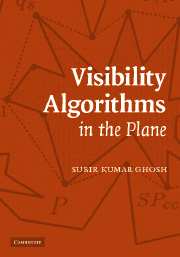4 - LR-Visibility and Shortest Paths
Published online by Cambridge University Press: 14 August 2009
Summary
Problems and Results
A simple polygon P is said to be an LR-visibility polygon if there exists two points s and t on the boundary of P such that every point of the clockwise boundary of P from s to t (denoted as L) is visible from some point of the counterclockwise boundary of P from s to t (denoted as R) and vice versa (see Figure 4.1(a)). LR-visibility polygons can be viewed as a generalization of weak visibility polygons (discussed in Chapter 3). We know that a simple polygon P is a weak visibility polygon from a chord if there exists two points s and t on bd(P) such that (i) s and t are mutually visible, and (ii) every point of the clockwise boundary from s to t is visible from some point of the counterclockwise boundary from s to t and vice versa. If the condition (i) is removed, then it defines LR-visibility polygons, which contains weak visibility polygons as a subclass. It can be seen that if a point moves along any path between s and t inside an LR-visibility polygon, it can see the entire polygon. LR-visibility polygons are also called streets and this class of polygons was first considered while studying the problem of walking in a polygon. For more details, see Icking and Klein [200] and Klein [219].
Information
- Type
- Chapter
- Information
- Visibility Algorithms in the Plane , pp. 105 - 135Publisher: Cambridge University PressPrint publication year: 2007
